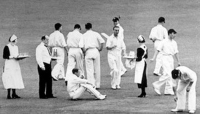Old Fashioned Batting Tips for Modern Run Makers
 Are you confused by the explosion of batting methods in recent times? You should be.
Are you confused by the explosion of batting methods in recent times? You should be.
Batsmen are expected to contribute more runs in less time from 1-11 these days. You can thank Twenty20. As a result there are more outrageous shots played with more confidence than ever before. I saw a club game not long ago where the number 9 played a scoop shot several times! Yes, these days it's all about finding your own method.
But don't panic.
There are some things that still work for most players most of the time. They are timeless classic tips that coaches have taught for decades. They are the place you start, and the place you go back to when you want to get back to basics after a run of bad form.
In a ground-breaking world, it's reassuring that some things don't need to break new ground. Here they are:
Stand still
Despite trigger moves and crease management it's still a core skill to be still as the ball is released.
This is to do with simple ball tracking. If you want to pick line and length early you need to be have a still point from which to work. If your head and eyes are moving, it takes longer for your brain to work out where the ball is going.
Do what you like before the bowler bowls - and after you have picked the line and length - but you better have a darn good reason to be moving when he lands his front foot. If you don't have that reason, make sure you are still at ball release.
Play straight
Batting is a 360 degree exercise now. But if you are playing the percentage game, it's still much better to play on, straight and off drives as your first option.
Why is this?
Most balls are bowled between half volley and back of a length, on or just outside the stumps. The best way to try and hit a ball like this is to use the face of the bat in a line that swings opposite to the ball: hitting it straight. If you misjudge you are less likely to miss the ball compared to trying to hit across the line.
If you are batting up the order in longer games, you can wait for the ball to drive and hit straight between extra cover and midwicket, in "the V". This is classical batting.
What if you need to get on with it and score quickly? You can still hit length balls straight. You can hit in the air straight for boundaries.
Of course, you can still play fancy shots and score well if the situation dictates, you have your eye in, or your ability allows. That said, I would argue that your default position is to hit the ball straight and it should be an element of your game that you practice tirelessly as it will give you the best results in the long term.
Play late
We all know batsmen who "time" it. What they lack in power they make up by playing the ball later in its trajectory. What looks like a gentle tap flows quickly to the boundary. Bell. Tendulkar.
Timing is a complex thing that happens in fractions of seconds involving your whole body balance and alignment, and two objects, only one of which is under your direct control (the bat). For most of us this is made easier by the maxim to "play late". You have probably heard one of these vague coaching terms as you bat in nets:
- Wait for it a little longer
- Play the ball under your eyes
- Try to time your swing
- Time it, don't hit it
- Hit the ball half as hard as you think you should
- Wait, wait, wait. Go, go, go!
Perhaps one of these resonated with the way you think, perhaps they didn't - it's a tough concept to explain and is better felt - but the basic principle is the same; the later you can hit the ball the better it is for your batting.
This will take some experimentation from you to get right. Not everyone is the same, with some batters better at timing the ball out in front, that is to say not "under the eyes". Kevin Pietersen is the prime example. Other players prefer to do it in the more traditional way.
Additionally, there are differences in head and foot position between players. Stances and backswings also vary. None are wrong in all cases. Some are right for some people.
What trends across better players is that they "play late" within their own style. A good batsman picks line and length early, gets into a strong position early and then has time to decide when to begin their downswing for perfect connection with the ball.
- Login to post comments

